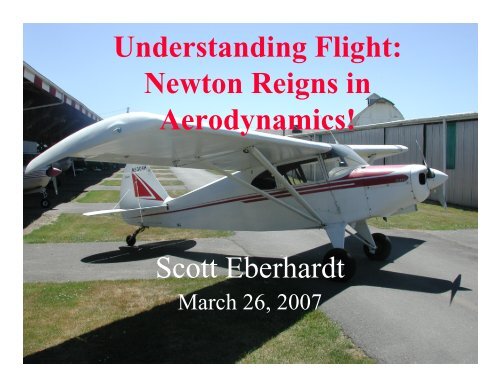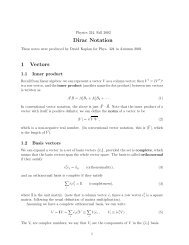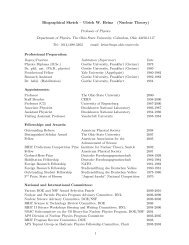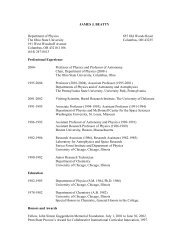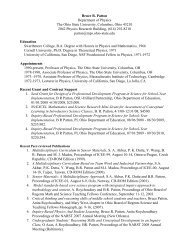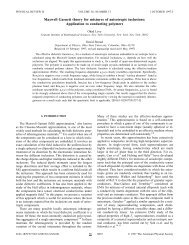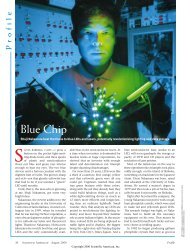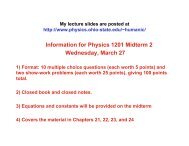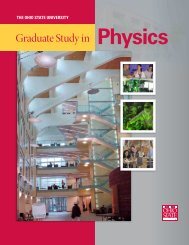Dr. Eberhardt's Talk
Dr. Eberhardt's Talk
Dr. Eberhardt's Talk
Create successful ePaper yourself
Turn your PDF publications into a flip-book with our unique Google optimized e-Paper software.
Understanding Flight:<br />
Newton Reigns in<br />
Aerodynamics!<br />
Scott Eberhardt<br />
March 26, 2007
General Aviation
Military Aviation
Commercial Aviation
What you will learn today<br />
• Some of the things you learned might<br />
be wrong<br />
• The physical description of lift, using<br />
Newton’s Laws<br />
• The connection between lift and power<br />
• Some ideas about why wings look the<br />
way they do
Descriptions of Lift
Explaining Lift<br />
• Mathematical description<br />
–Taught to Aeronautical Engineers<br />
• Popular description<br />
–Taught by flight schools, FAA,<br />
NASA, etc<br />
• Physical description<br />
–What you are learning today
The Myth of the Bumblebee – The Aerodynamicist’s Bane<br />
The tabloids do<br />
it to science<br />
again?<br />
Aerodynamicist Proves<br />
Bumblebees Can’t Fly!<br />
Seattle<br />
Muckraker<br />
$1..00<br />
September 10<br />
Elvis is Alive,<br />
Living in<br />
Argentina<br />
News Flash….<br />
Britney Spears<br />
to run for governor<br />
of New York<br />
Guru remains<br />
in trance<br />
for 20 years<br />
..without food or drink<br />
A 380<br />
Giant fly<br />
devours<br />
jumbo jet<br />
…. Hundreds missing<br />
Astrophysicists find dark matter<br />
…its cosmic cow poop
The Actual Origin of the Bumblebee Myth<br />
From A. Magnan, Le Vol Des Insects,<br />
Paris: Herman and Cle, 1934 (p. 8):<br />
“Tout d’abord, pouss’e par ce qui fait en<br />
aviation, j’ai applique’ aux insectes les<br />
lois de la resistance del’air, et je suis<br />
arrive’ avec M. [Andre] SAINTE-LAGUE a<br />
cette conclusion que leur vol est<br />
impossible.”
Popular Description of Lift<br />
(what you might have learned)<br />
• Bernoulli relates pressure to<br />
velocity<br />
• Focuses on shape of wing to<br />
determine velocity<br />
• Perpetuates Myths
Physical Description of Lift<br />
“Forget Bernoulli’s Theorem”<br />
Stick and Rudder, published 1944
Lift is a Reaction Force
Physical Description<br />
• Based on Newton’s laws<br />
• Easy to understand without<br />
equations<br />
• Leads to an understanding of<br />
power required for flight
Newton’s Third Law<br />
To every Action there is an<br />
equal and opposite Reaction
Newton’s First Law<br />
A body at rest will remain at rest,<br />
or a body in motion will continue<br />
in straight line motion unless subjected<br />
to an external applied force
So….<br />
For a wing to go up<br />
it must force air down<br />
Lots of air!
Cessna Citation flying over fog<br />
(Photo By Paul Bowen)
A Rotating Wing Pushes Air Down
Does this picture show an<br />
airfoil generating lift?
No, the air must experience a<br />
net change, as shown below<br />
Upwash<br />
Downwash
Downwash<br />
Wing pulls air down -- Downwash<br />
Downwash is related to angle of<br />
attack and airspeed, which the<br />
pilot can control
Why does the air follow the<br />
top surface of the wing?
Nature Abhors a Vacuum<br />
This cannot happen
Air could fill from below?
Air could fill from below?<br />
Can’t happen (except in “superfluids”)
Air could fill from back
Air could fill from back
Stall on flat plate
Air could fill from top
Air could fill from top
Air<br />
Picture a curved hose<br />
Force
Air<br />
Hose is like an airfoil<br />
Force
Viscosity<br />
Force on glass<br />
Force on water
Newton’s Second Law<br />
The thrust of a rocket is equal to the<br />
velocity of the exhaust times the amount<br />
of mass ejected per second
Newton’s 2nd law<br />
applied to a wing<br />
The lift on a wing is proportional<br />
to the amount of<br />
air diverted per second times<br />
the vertical velocity of the air<br />
Lift = mass/sec * vertical velocity
Lift<br />
So, wing diverts air down for lift<br />
Lift = mass/sec * vertical velocity<br />
or<br />
Lift = (m/t) * V downwash<br />
(m/t) is mass flow rate of air<br />
pumped down
Diverted Air<br />
The amount of air diverted is<br />
proportional to:<br />
•The speed<br />
•The air density
The wing as a scoop<br />
The scoop can be calculated with<br />
the “Biot-Savart Law.”
Vertical Velocity<br />
The vertical velocity is proportional<br />
to:<br />
•The speed<br />
•The angle of attack
Vertical Velocity<br />
a:<br />
b:<br />
c:<br />
Speed (x2)<br />
Downwash<br />
Pilot controls airspeed and<br />
angle of attack<br />
α<br />
Speed<br />
α<br />
Downwash<br />
Speed<br />
α(x2)<br />
Downwash<br />
Vv<br />
Vv(x2)<br />
Vv(x2)
Angle of Attack
Lift is a Function of<br />
Lift<br />
1<br />
Angle of Attack<br />
Critical angle of attack<br />
5 10 15 20<br />
Effective angle of attack (degrees)<br />
(at constant density and speed)
Vertical Velocity<br />
Vertical velocity is related to<br />
angle of attack and the airspeed<br />
of the wing<br />
Pilot controls airspeed<br />
and angle of attack
How much air is pushed<br />
down?<br />
A Cessna 172<br />
diverts approximately<br />
5 times its own weight per second!
What’s going on in this photo?
Summary of Lift<br />
• Lift is proportional to:<br />
Amount of air diverted per second<br />
Downwash velocity of that air<br />
• Amount of air diverted per second is proportional<br />
to: Speed of wing<br />
Density of air<br />
• Downwash velocity of air is proportional to:<br />
Angle of attack<br />
Speed of wing
T=0<br />
Myth: 1<br />
Particles reach trailing edge at same time.<br />
T f
With Equal Transit times,<br />
How Can...<br />
• An airfoil fly upside down?<br />
• A paper airplane fly?<br />
• A wing fly in ground effect?<br />
Equal transit times says it can’t happen<br />
Equal transit times is wrong!
Reality<br />
Air goes much quicker over the top
Lift is a Function of<br />
Lift<br />
1<br />
Angle of Attack<br />
Critical angle of attack<br />
5 10 15 20<br />
Effective angle of attack (degrees)
Myth #2<br />
These two pictures are not<br />
the same thing
Cessna Citation flying over<br />
fog<br />
(Photo By Paul Bowen)
Summary of Lift<br />
• Lift is proportional to:<br />
Amount of air diverted per second<br />
Downwash velocity of that air<br />
• Amount of air diverted per second is proportional<br />
to: Speed of wing<br />
Density of air<br />
• Downwash velocity of air is proportional to:<br />
Angle of attack<br />
Speed of wing
Power
If Lift didn’t require Power<br />
• Planes would have same range<br />
empty or full<br />
• Helicopters could hover at any<br />
altitude and load<br />
• Propulsion would not require<br />
power either (same physics)
Power required for lift<br />
• Power is Force times Velocity<br />
• “Induced Power” is the lift times<br />
the vertical velocity<br />
Induced Power = Lift * Vertical Velocity
What is the Lift?<br />
•Lift = Weight<br />
(for straight and level flight)<br />
•Weight isn’t changing<br />
•Lift is constant<br />
So
How does Vertical Velocity<br />
Change?<br />
As speed increases, more air passes<br />
past wing so the amount of air diverted<br />
per second increases.<br />
Lift = (m/t) * vertical velocity<br />
or<br />
Vertical velocity = Lift/(m/t)
Therefore, as speed increases,<br />
downwash decreases
So,<br />
Induced Power= Lift * Vertical Velocity<br />
Induced Power decreases with speed!<br />
But, don’t forget power to overcome<br />
skin and form drag
Induced Power<br />
At half the speed:<br />
Half the air is diverted<br />
therefore, you need to double<br />
the vertical velocity by increasing<br />
the angle of attack<br />
Induced power goes as 1/speed
Power<br />
120<br />
100<br />
80<br />
60<br />
40<br />
20<br />
0<br />
Induced Power<br />
Cessna 172 “Skyhawk”<br />
0 20 40 60 80 100 120 140 160<br />
V - mph
Parasitic Power<br />
The energy loss to collision with the air<br />
is proportional to speed squared (1/2mv 2 )<br />
Number of collisions is proportional<br />
to speed<br />
Parasitic power goes as speed cubed
Power<br />
120.0000<br />
100.0000<br />
80.0000<br />
60.0000<br />
40.0000<br />
20.0000<br />
0.0000<br />
Parasitic Power<br />
Cessna 172 “Skyhawk”<br />
0 20 40 60 80 100 120 140 160<br />
V - mph
Power<br />
120.0<br />
100.0<br />
80.0<br />
60.0<br />
40.0<br />
20.0<br />
0.0<br />
Power Required<br />
Ve<br />
0 50 100 150<br />
V - mph
Langley’s Law
Summary of Power<br />
• Lift requires power<br />
• Power due to lift: Induced Power
Wing Efficiency
Wing Efficiency<br />
• Induced power is proportional to lift times vertical<br />
velocity<br />
• If you double the span of the wing you double the<br />
amount of air diverted and therefore halve the<br />
vertical velocity<br />
Induced Power and Induced <strong>Dr</strong>ag<br />
decrease as wingspan increases
Gliders have efficient wings
Classical Aerodynamics<br />
• Lift does no work!<br />
• But, classical aerodynamics<br />
assumes a wing of infinite span<br />
if span -> infinity<br />
power induced -> 0!
Summary<br />
• Lift is a REACTION FORCE<br />
• Lift is described using Newton’s<br />
Laws<br />
• Lift requires Power<br />
• High span increases wing<br />
efficiency
References<br />
• http://home.comcast.net/~clipper-108/Professional.html<br />
– English<br />
– French<br />
– Spanish<br />
– Italian<br />
– Japanese
Research Trends<br />
• From the University Perspective<br />
– “Smart” Structures<br />
– Active Flow Control<br />
– Coordinated and Formation Flying of UAV’s<br />
– Better Materials<br />
• From the Boeing Perspective:
Composite Structure<br />
Lower Maintenance<br />
Costs<br />
Innovative Systems<br />
Flexible for<br />
the Future<br />
Large Cargo<br />
Capacity<br />
More Revenue<br />
Potential<br />
Innovations That Add Value<br />
Breakthrough<br />
Cabin<br />
Passenger<br />
Preference<br />
Advanced Wing<br />
Enhanced<br />
Efficiency<br />
Enhanced<br />
Flight Deck<br />
Operational<br />
Reliability<br />
Advanced<br />
Engines<br />
Fuel Efficiency<br />
Lower Noise
Many Thanks!


